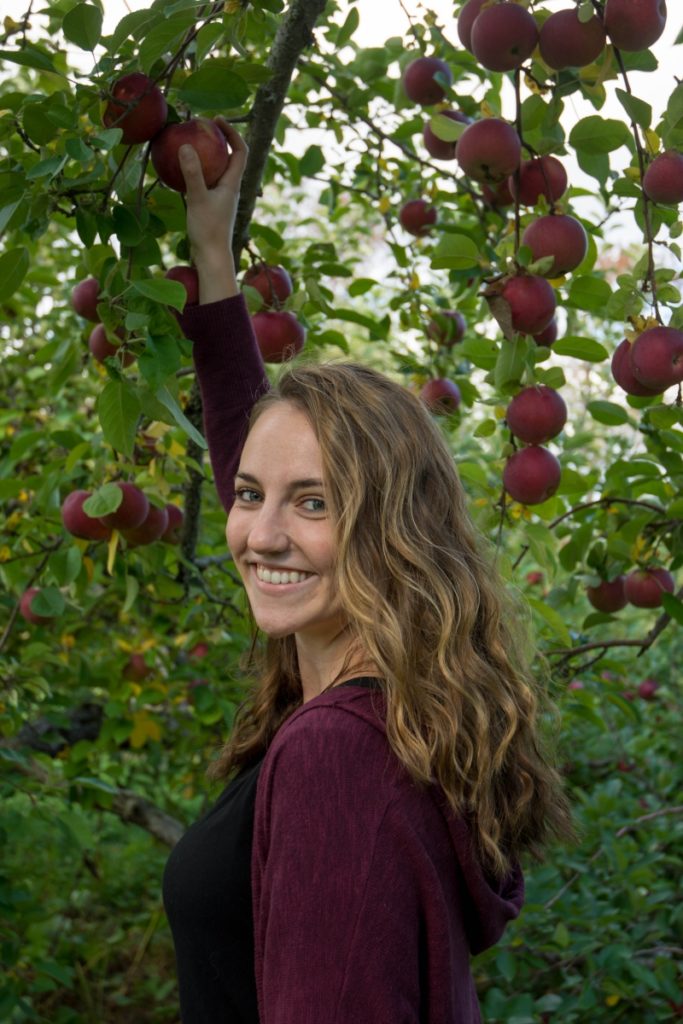University of New Hampshire researchers have teamed up with colleagues from Pennsylvania State University to investigate whether a byproduct of shrimp shells from the seafood industry could help manage one of the most devastating fruit diseases facing the U.S. apple industry.
UNH graduate student Liza DeGenring is investigating the development of new tools to manage apple scab for Northeast farmers. Specifically, she is investigating the combination of beneficial microbes with a natural compound called chitosan.
Many beneficial microorganisms associated with plants have been commercialized and sold as biopesticides for use in agriculture to reduce plant diseases. The tree fruit industry has begun adopting these alternative tools with some success. These products include Serenade ASO and Double Nickel 55, both of which rely on beneficial bacteria. Widespread adoption of biopesticides, however, has been limited due to inconsistencies in their effectiveness.
“Because biopesticides are living products, their activity is affected by environment. Biopesticides often fail to grow and maintain high enough population levels in the orchard or do not produce antifungal compounds at levels necessary to suppress the disease. It is increasingly recognized that solving these issues is key to increasing adoption of biopesticides. I am investigating a way to enhance biopesticide effectiveness using chitosan. There is evidence that chitosan may act as a food source for the biopesticides and stimulate production of antifungal enzymes, thereby enhancing their usefulness,” she said.
Much of the research around chitosan has focused on the reduction of postharvest disease—once the fruit or vegetable has been harvested. Chitosan has shown to be effective in reducing plant disease and preserving fruits and vegetables during storage and transport. Researchers at UNH would like to extend this research to investigate the effect of a chitosan application during crop production and in combination with an application of biopesticides.

DeGenring is working with NH Agricultural Experiment Station researcher Anissa Poleatewich, assistant professor of plant pathology and her faculty advisor. Collaborators include George Hamilton and Jeremy DeLise, both with UNH Cooperative Extension, and Kari Peter at the Pennsylvania State University Fruit Research and Extension Center.
“Reduced fruit quality is a major concern for the New Hampshire tree fruit industry since NH growers primarily market retail sales of fresh apples through pick-your-own, farm stands, and direct sales to grocery stores. Apple scab lesions on the fruit can result in decreased revenue to the grower due to consumers’ low threshold for imperfections on their apples,” DeGenring said.
Apple scab, caused by the fungus Venturia inaequalis, is one of the most destructive diseases of apple worldwide. This disease is a significant threat to growers in the Northeastern United States because of the warm, moist conditions during the growing season that favor disease development. Apple scab can cause up to 100 percent crop loss and significant reduction in fruit marketability. According to the USDA National Agricultural Statistics Service, the market value of apples nationwide was $2.4 billion. The New Hampshire tree fruit industry includes 228 farms growing 1,701 acres of tree fruit, valued at $9.3 million.
According to Poleaewich, apple growers in New England and the Potomac states have been battling apple scab and fireblight for decades. These diseases are more problematic in the Northeast than the Pacific Northwest due to the Northeast’s warm, wet climate that favors disease outbreaks.
“UNH has a historical reputation of conducting apple scab research. Much of what we know today about the disease is based on work done by William MacHardy, professor emeritus of plant biology. New Hampshire tree fruit growers have a strong history of collaboration with UNH to develop and adopt more environmentally and economically sustainable practices. In the 1980s, MacHardy and colleagues developed disease-forecasting models that growers still use today to predict outbreaks and apply fungicides only when disease risk is high. New Hampshire growers also have adopted Integrated Pest Management, which incorporates cultural, biological, and chemical practices to suppress disease. Even with these advances, apple scab continues to be a major nemesis to tree fruit growers,” Poleaewich said.
To combat apple scab disease, growers primarily rely on sanitation and fungicide applications in their orchards. However, there is increasing pressure by consumers to decrease the use of synthetic chemicals due to concerns of adverse effects on nonpest species and human health, as well as the risk ofpathogenresistance development with regular fungicide applications. Both the potential decrease in consumer demand and increased costs of resistant pathogen management can decrease producer profits.
“Both
farmers and apple consumers would like alternative options for
controlling apple scab. Chitosan has shown promise
in other research in reducing disease, and there is a potential to use
it to suppress disease in tree fruit production,” DeGenring said.
According to DeGenring, the success of sustainable agriculture in the United States
will increasingly rely on the integration of biologically based methods with
conventional agricultural practices that rely on fungicides.
The scientific and agricultural community has begun to recognize the
critical role microorganisms, such as bacteria and fungi, and their
metabolites play in agroecosystem health.
This material is based upon work supported by the NH Agricultural Experiment Station, through joint funding of the National Institute of Food and Agriculture, U.S. Department of Agriculture, under award number 1016530, and the state of New Hampshire. This work is also funded by a Northeast Graduate Student USDA Sustainable Agriculture Research and Education grant and a New Hampshire Specialty Crop Block grant.


 Return to the Concord Monitor
Return to the Concord Monitor